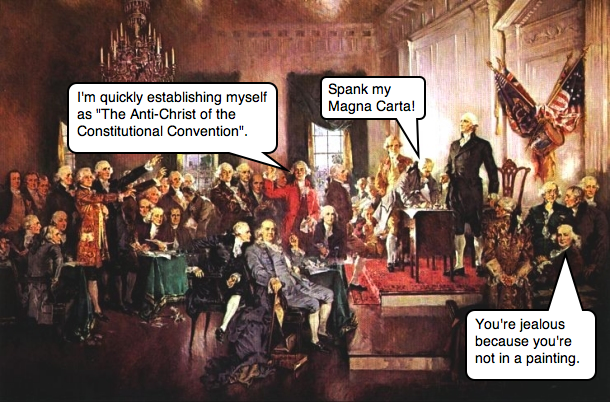
Home • About • Spank My Monkey: The Full Story • Media • Spank My Monkey Photo • PowerTV • Tenneco • Anti-Christ of the Hot Rod World Video • Richard Rawlings • Corky Coker • David Coker • SEMA • The Learning Channel • The Bullrun • Dodgy Monkey Media • Is that Fake Rust? • It Looks Like... • Sponsors • Comic Gallery • The SpankMaker • Parody and the Law • Legal Action • How You Can Help Parody and the LawParody and Free SpeechWhen the United States Founding Fathers framed The Constitution, they made sure that Americans would always have the right to peacefully protest and criticize. In America, one of the forms of criticism that's specifically protected is parody. A parody is a work that imitates another work for the purpose of ridicule or ironic commentary. The US Supreme Court recognizes parody as a protected form of free speech, and parodies are even given special rights under copyright law. As a result of hundreds of years of protecting parodies, the concept of parody has been firmly rooted in American culture. Parodies of celebrities and public figures are on popular television and radio shows. There are also parody magazines, parody songs, and entire parody movies. There are even parody websites. Ironically, politicians themselves are among the most frequently parodied figures. 
Parody and Copyright Law Parodies, by their nature, typically make use of other works: music, art, corporate logos, advertisements, etc. Obviously, the creators and owners of copyrighted works are unlikely to grant permission for their works to be used in a parody. However, American society recognizes the cultural value of parody as a form of criticism and commentary, so the use of such copyrighted works for purposes of parody is often considered "fair use", and is thus perfectly legal. The section of US law that deals with fair use is Title 17, Chapter 1, Section 107: Limitations on exclusive rights: Fair use.[1] Here's the exact text of the law: Notwithstanding the provisions of sections 106 and 106A, the fair use of a copyrighted work, including such use by reproduction in copies or phonorecords or by any other means specified by that section, for purposes such as criticism, comment, news reporting, teaching (including multiple copies for classroom use), scholarship, or research, is not an infringement of copyright. In determining whether the use made of a work in any particular case is a fair use the factors to be considered shall include -- Parody is recognized as a form of criticism and commentary. Here's how a parody might be considered, in light of the four factors above used to determine fair use:
Campbell v. Acuff-Rose Music One of the Supreme Court cases that's frequently cited in parody situations is Campbell v. Acuff-Rose Music, which involved a copyright dispute over a song by the rap music group 2 Live Crew, headed by Luther Campbell. 2 Live Crew had composed a song called "Pretty Woman", which was a parody of the 1964 Roy Orbison hit song, "Oh, Pretty Woman". Acuff-Rose Music was the publishing company that managed the rights to the Orbison song, and 2 Live Crew asked them if they could license it for purposes of parody. Acuff-Rose denied their request -- 2 Live Crew ignored them, and produced the song anyway. The 2 Live Crew parody song sold nearly a quarter of a million copies. Acuff-Rose Music sued for copyright infringement. After a District Court decision in favor of 2 Live Crew, and a reversal at the Court of Appeals, the case reached the Supreme Court in November of 1993. The Supreme Court ruled unanimously in favor of Luther Campbell and 2 Live Crew. Even though the 2 Live Crew parody song was commercial (and profitable), The Supreme Court held that the commercial nature of the parody was not enough to render it unfair use, and that "a parody's commercial character is only one element that should be weighed in a fair use inquiry."[2] While 2 Live Crew had copied a substantial amount of the "heart" of the original Orbison song, the Supreme Court said that "the heart is also what most readily conjures up the song for parody, and it is the heart at which parody takes aim".[2] The Supreme Court also clarified the interpretation of a parody's potential effect on the market. It's understood that a parody, like any negative review, can destroy the market for the original work. Therefore, in parody situations, what's measured is "market substitution, not any harm from criticism"; whether the parody can substitute for the original in the market, not whether the parody will harm the market for the original work. A parody is considered unlikely to act as a substitute for an original work, since it usually serves a different market purpose. The unanimous ruling in Campbell v. Acuff-Rose Music significantly strengthened the fair use defense for parodists. Despite commercial profit, substantial copying, and allegations of market harm, the 2 Live Crew song had been protected from a charge of copyright infringement by one defining condition -- it was a parody. Related Information on SpankMyMarketer.com
References
|
|
Home • About • Spank My Monkey: The Full Story • Media • Spank My Monkey Photo • PowerTV • Tenneco • Anti-Christ of the Hot Rod World Video • Richard Rawlings • Corky Coker • David Coker • SEMA • The Learning Channel • The Bullrun • Dodgy Monkey Media • Is that Fake Rust? • It Looks Like... • Sponsors • Comic Gallery • The SpankMaker • Parody and the Law • Legal Action • How You Can Help |